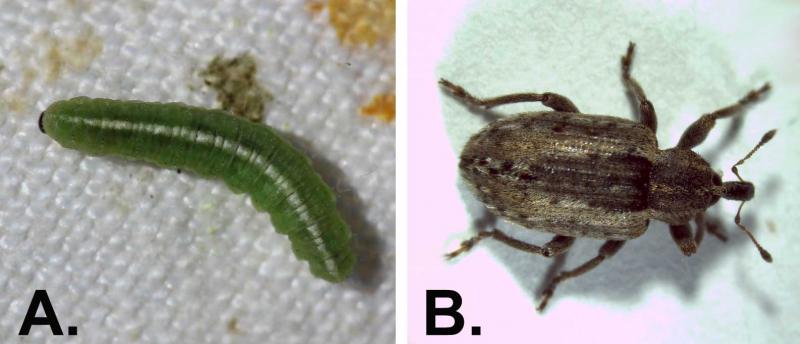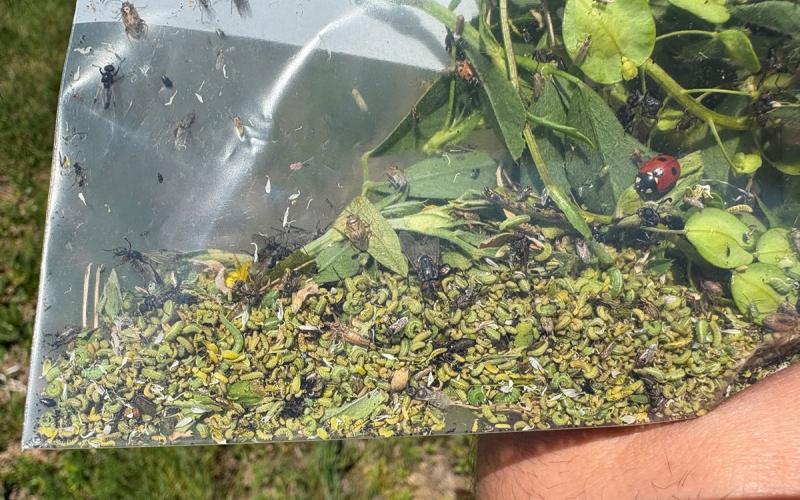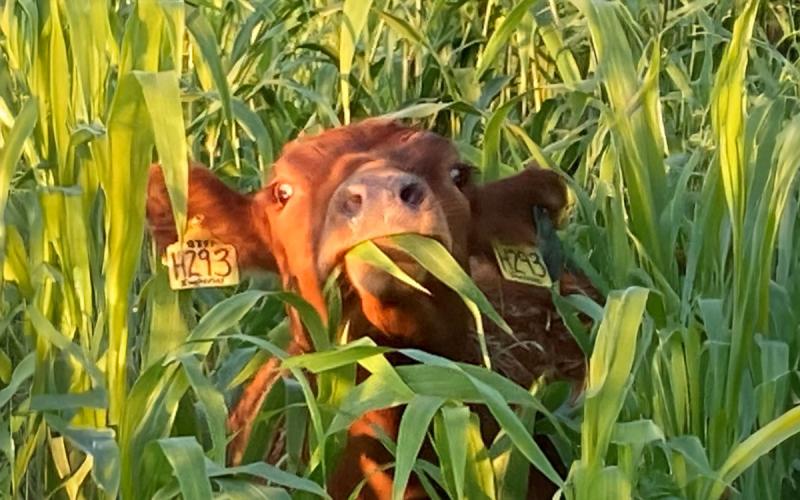Originally Submitted: May 13, 2021
For the last few weeks, estimations of alfalfa weevil activity based on degree days were indicating that alfalfa weevils shouldn’t be active within fields. However, we received our first activity reports this week. Scouting and managing alfalfa weevils when they reach the determined thresholds can prevent yield loss and encourage healthy regrowth of the infested stand. Alfalfa weevil adults and larvae both feed on the alfalfa plant. However, the larvae cause the greatest damage by feeding on the terminal buds of the plant, which can greatly impact alfalfa growth.
Alfalfa Weevil Identification

The larvae of the alfalfa weevil are small, green and resemble caterpillars. They have a white stripe on their backs and a dark brown/black head capsule (Figure 1-A). The larvae will have three pairs of legs near their head. The adults are small, brown beetles with a darker brown stripe that runs down their midline. Alfalfa weevil adults also have an elongated snout that is characteristic of the weevil family (Figure 1-B).
Scouting
The best way to determine if alfalfa weevils are present in a field is to use a sweep net and a five-gallon bucket. If you confirm alfalfa weevils are present in a field, the next step is to determine their population density. To do this, we recommend walking in a “Z” pattern and randomly sampling a total of 30 plants (i.e., sample approximately 10 plants per leg of the “Z”). Each plant that is selected needs to be pulled out gently and then hit against the inside of the five-gallon bucket to dislodge any larvae that are present. We recommend this method versus trying to count the beetles and larvae on the intact plant, because adult alfalfa weevils will fall off the plant when disturbed as a defense mechanism.
Once completed, the plant should be measured to determine height and the number of larvae in the bucket should be counted. Repeat this process until a total of 30 plants have been sampled. Lastly, calculate the average number of larvae and the height of the plants. Tables 1–4 contain threshold information for alfalfa weevils based on plant height and the number of larvae present.
Economic Thresholds
|
|
||||
|---|---|---|---|---|
|
|
|
|
|
|
| Value of hay per ton |
|
|||
| $60 |
|
|
|
|
| $80 |
|
|
|
|
| $100 |
|
|
|
|
| $120 |
|
|
|
|
| $140 |
|
|
|
|
| $160 |
|
|
|
|
| $180 |
|
|
|
|
| $200 |
|
|
|
|
| $220 |
|
|
|
|
|
|
||||
|---|---|---|---|---|
|
|
|
|
|
|
| Value of hay per ton |
|
|||
| $60 |
|
|
|
|
| $80 |
|
|
|
|
| $100 |
|
|
|
|
| $120 |
|
|
|
|
| $140 |
|
|
|
|
| $160 |
|
|
|
|
| $180 |
|
|
|
|
| $200 |
|
|
|
|
| $220 |
|
|
|
|
|
|
||||
|---|---|---|---|---|
|
|
|
|
|
|
| Value of hay per ton |
|
|||
| $60 |
|
|
|
|
| $80 |
|
|
|
|
| $100 |
|
|
|
|
| $120 |
|
|
|
|
| $140 |
|
|
|
|
| $160 |
|
|
|
|
| $180 |
|
|
|
|
| $200 |
|
|
|
|
| $220 |
|
|
|
|
|
|
||||
|---|---|---|---|---|
|
|
|
|
|
|
| Value of hay per ton |
|
|||
| $60 |
|
|
|
|
| $80 |
|
|
|
|
| $100 |
|
|
|
|
| $120 |
|
|
|
|
| $140 |
|
|
|
|
| $160 |
|
|
|
|
| $180 |
|
|
|
|
| $200 |
|
|
|
|
| $220 |
|
|
|
|
Management
If thresholds are exceeded, there are several insecticides available for management. Please refer to the latest South Dakota Pest Management Guide - Alfalfa and Oilseeds for labeled insecticides and their rates. Neighboring states have received reports of pyrethroid failures when these insecticides were applied to manage alfalfa weevils. If you observe a pyrethroid failure, please let us know. You can reach Adam Varenhorst at 605-688-6854 or by email.


